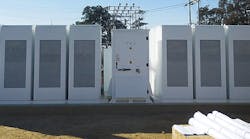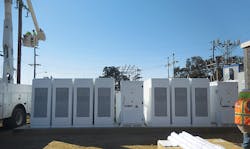More than 3.7 million electric vehicles (EVs) were sold worldwide over the past two years. That’s creating business opportunities for electrical contractors, many of which aren’t immediately obvious. One case in point involves electric utility-scale battery energy storage systems (BESS), which typically use the same lithium-ion (Li-ion) technology as EVs. As EV sales grow, so do Li-ion volumes. That helps send Li-ion technology down the cost curve, making BESS more attractive to more electric utilities.
“One of the largest drivers is the rapidly declining cost,” says Roger Lueken, a senior associate at The Brattle Group, which tracks the utility market. “We’ve seen double-digit percentage [declines] per year for battery packs for the past 10 years.”
The EV trend is also prompting electric utilities to look for new ways to keep up with demand. For example, a household with one or more EVs can use four to five times more electricity than homes without. BESS is one way to manage that demand, such as with batteries installed in or near neighborhoods with high concentrations of EVs. During the day, when most of those vehicles are elsewhere, solar or wind systems can charge the batteries. At night, they help shoulder the increased charging load.
“BESS also provides utilities with new flexibility to generate, control, and manage power within their grid,” says Clay Williams, project executive for energy/utilities at Pittsburgh-based Sargent Electric Co. “Many utilities are considering BESS to replace their peaker plants.
“Also, the utilities can dispatch the power, or have the grid operators dispatch the power, at times of peak demand, which will result in a higher price per kilowatt-hour being sold. The utilities may be able to obtain a more lucrative power purchase agreement.”
Finally, BESS is another option for serving customers in areas prone to outages. Take the example of a remote, six-home subdivision fed by a 20-mile-long distribution line that passes through an area where wildfires are common. A BESS could support a microgrid for those customers to ensure they have power when that line goes down. It also could eliminate the need for that line altogether.
“Right now, we’re working with PG&E on concepts installing some kind of battery and solar install — it [also] could be a gas generator with a battery — in these really remote systems,” says Brian McDonald, senior vice president for San Jose, Calif.-based Cupertino Electric, Inc. (CEI). “We’re finding it’s a lot cheaper to do that than run a new 20-mile line for a very small amount of load.”
Ducking the Sun
Increased electric utility investment in renewables is another major driver of the BESS market. The batteries store energy so it can be used when the sun isn’t shining or the wind isn’t blowing. As a result, BESS helps flatten out the “duck curve.” If solar production were a line on a graph, it would look like a duck’s back and neck, with output dropping and then increasing during the course of 24 hours.
“It’s critical from the standpoint of the duck curve that we see in places with deep solar penetration like California,” says Ken Boyce, UL principal design engineer. “It’s very difficult for utilities to meet [demand] in the afternoon when solar production starts to wane and energy usage goes up.
“You’ll see this rapid increase: the neck of the duck is very steep. Energy storage helps lower the head and raise the belly a bit.”
The duck curve is one example of how electric utilities can use BESS to manage the grid.
“We see a lot of focus, especially on the utility-scale systems, about supporting grid health, [such as] frequency regulation and voltage regulation,” Boyce says. “Energy storage is a key asset for enabling that kind of grid health.”
Pairing BESS with renewables also has business benefits.
“We do design-build solar farms,” McDonald says. “We’re building about six right now. Most of them have carve-outs on their footprints with a long-term focus of having battery storage installations contemplated.
“A lot of the developers are one step ahead of thinking about the viability of putting in battery storage with their solar farms. That will help make their products more marketable: You can have more of a 24/7 product to offer. I think we’re going to see more and more of that, especially as the costs come down.”
Regulations help and hurt
State and federal governments are using both carrots and sticks to drive the BESS market.
“There’s a lot of interest in pairing BESS with solar systems in what people call ‘solar-plus’ storage configurations,” Lueken says. “This is partially driven by the federal investment tax credit, which says if you pair a battery and collocate it with a solar farm, and only charge it with energy from that solar farm, you can earn the federal investment tax credit on the storage.”
Another key federal ruling is FERC Order 841, issued in February 2018. It required wholesale market operators such as ISOs to update their rules so energy storage (ES) can participate alongside other generation technologies. The ruling also anticipates a point — in five to 10 years, according to the research firm GTM — when ES will be competitive with gas-fired peaker plants.
“In the parts of the country that are operated under central competitive markets (which is about one-third), the rules were established before ES was thought to be a practical technology,” Lueken says. “Over the past year, those markets have been revising their rules so that storage can compete on a more level playing field. Those tariff revisions are coming into effect, I think, in December 2019.”
Meanwhile, at the state level, California, Massachusetts, and New York are among those with energy storage mandates.
“Several more are investigating whether they should have energy storage mandates,” Lueken says. “We worked on a study for the commission in Nevada helping them evaluate if adding storage would be beneficial and, if so, how much. That’s an ongoing proceeding right now. Other states have commissioned studies. So, there’s a lot of interest at the state level about whether to mandate storage.”
State mandates can also limit electric utility interest and investment. For example, Oncor created the Neighborhood Reliability Storage Initiative in 2014 “to evaluate effectiveness of deploying small-scale battery storage for the purpose of bridging short duration outages and improving local power quality.” Featuring six 25kW Li-ion batteries designed to cover outages of a few hours, the project ended after one year.
“We have not installed any since then because the state of Texas ruled that utilities like Oncor cannot own those assets directly,” says David Treichler, director of strategy and technology. “It has to go through a third party that would put them in.”
Oncor’s decision also shows how regulations affect the types of companies that electrical contractors need to focus on when targeting the electric utility BESS market: not only the electric utilities themselves, but also third parties such as Stem, an energy-storage-as-a-service provider. Another factor is that some electric utilities do the work themselves, while others hire contractors.
“Private contractors did most of the work on the Neighborhood Reliability Storage Initiative,” Treichler says. “Some utilities insource that. But that kind of work, we tend to outsource. We have a stable of contractors that we work with.”
Sargent also sees it going both ways.
“It is not uncommon for these projects to be prime contracted by an electrical [contractor] capable of performing EPC or design-build work,” Williams says. “Utilities may have an MSA with an engineering firm that may engineer the system but then solicit electrical contractors for the installation.
“Mainly [it] varies by the utility and their processes, as well as the size of the project. In the case of our 400MWh Alamitos project in Long Beach, Calif., we are contracted to Fluence, who is performing the engineering and design for their client AES.”
Safety as a Business Opportunity
Existing relationships with electric utilities help pave the way when they decide to start deploying BESS.
“Getting on the pre-qualified list opens doors,” Treichler says.
Another asset is understanding the safety challenges that electric utilities face with BESS, as well the relevant UL safety standards (see Sidebar below). One example is UL 9540, which was the world’s first for BESS and is now the national standard for the U.S. and Canada.
“It’s influencing the development of some of the IEC standards that are still a way off from being finalized,” Boyce says. “It covers the entire range, from utility scale to commercial scale to residential.
“It’s a really important foundation for what’s being done in the codes world, as well. We’re seeing documents like the NEC that governs safety of the electrical aspects of the infrastructure, and the International Fire Code, and the new NFPA 855 standard that just published for installation of ES. Those documents are pointing to UL 9540 as kind of a critical aspect for safety of the system itself.”
Some electrical contractors have fire suppression in their portfolio. That sets up an opportunity to leverage UL 9540A, which covers fire testing for BESS. Li-ion has flammable electrolytes and is susceptible to thermal runaway, where battery cells heat up as chemical processes speed up. A runaway cell can burst into flame or explode, triggering thermal runaway in surrounding cells.
“What starts as a small-scale event in a single cell can propagate up to a unit level or even a facility level, catastrophic event,” Boyce says.
This risk creates opportunities for contractors. For example, battery management systems (BMS) monitor status of each cell — including how it’s being charged and discharged — to ensure its kept in a safe operating mode.
“The BMS is the brakes in terms of keeping the batteries safe,” Boyce says.
Some electric utilities operate their BMS, while others outsource it as a managed service. So, there are opportunities for electrical contractors to bundle BMS managed services into their design and installation packages.
“Each project is different,” says Sargent’s Williams. “Typically, the electrical contractor works with the end-user/owner on a O&M agreement to maintain the facility, although the facilities require very little maintenance.
“The electrical contractor will change out components and replace batteries, which Sargent recently did for a project from 2015 with replacement occurring in 2018 at 10MW facility. The BESS itself (battery warranty, software, hardware, etc.) is maintained by the BESS technology company, such as Fluence or Tesla. The BESS tech companies are typically contracted by the utilities and/or end-users, and then the BESS companies contract the electrical contractors.”
A BMS managed service could include updating and patching the BMS software, a process that’s covered in UL 5500.
“It’s a very important aspect of real-world system maintenance,” Boyce says. “Having a plan and having a trusted partner making sure those things are done the right way is really important.”
Finally, one challenge for electric utilities and contractors alike is that Li-ion BESS is still a relatively new technology. So, time will tell how batteries age and how that affects costs such as replacement and maintenance — variables to consider when structuring a managed services contract.
“Most BESS utility contracts require a 20-year performance guarantee,” says CEI’s McDonald. “Yet many Li-ion products have not been installed for even 10 years. Since we design, integrate, and build the entire energy system, CEI is well suited to provide post-construction operations and maintenance support to ensure system performance guarantees are met for the customer.”
Kridel is an independent analyst and freelance writer with experience in covering technology, telecommunications, and more. He can be reached at [email protected].
Sidebar: Relevant Standards at a Glance
UL 9540, “Standard for Energy Storage Systems and Equipment,” is the world’s first safety standard for BESS, and is now the national standard for the U.S. and Canada. https://standardscatalog.ul.com/standards/en/standard_9540
UL 9540A, “Test Method for Evaluating Thermal Runaway Fire Propagation in Battery Energy Storage Systems,” includes fire testing processes, so it’s particularly useful for electrical contractors whose portfolios include fire suppression solutions. https://standardscatalog.ul.com/standards/en/standard_9540a_4
UL 5500, “Standard for Safety for Remote Software Updates,” applies to battery management systems, which are a potential managed-service opportunity for electrical contractors. https://standardscatalog.ul.com/standards/en/standard_5500_1
UL 1973, “Standard for Batteries for Use in Stationary, Vehicle Auxiliary Power and Light Electric Rail (LER) Applications,” includes mechanical, environmental and other tests to ensure safe, reliable installations. https://standardscatalog.ul.com/standards/en/standard_1973_2
UL 1741, “Standard for Inverters, Converters, Controllers and Interconnection System Equipment for Use With Distributed Energy Resources,” covers specifications for grid connections. https://standardscatalog.ul.com/standards/en/standard_1741_2
IEEE 1547-2018, “Interconnection and Interoperability of Distributed Energy Resources with Associated Electric Power Systems Interfaces,” provides additional technical specifications and testing methodology. https://standards.ieee.org/standard/1547-2018.html




